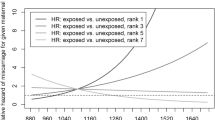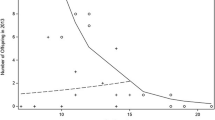Abstract
We evaluated the association between dominance rank and lifetime reproductive success of 75 free-ranging female baboons in Mikumi National Park, Tanzania. Data were evaluated over a 22-year period that included a period of troop increase (1975–1987) associated with two troop splits in 1978 and 1979, followed by a precipitous population crash (1987–1996) where the troops successively fused back together in 1989 and 1994. Lifetime reproductive success was significantly greater for high- versus low-ranking females when examined across the entire study period. High-ranking females had a longer reproductive life span (7.4 vs 3.6 years after first birth), reached menarche earlier (4.6 vs 5.2 years), lived longer (12.0 vs 8.8 years), and had more offspring of both sexes (2.25 vs 1.33 for male offspring; 3.25 vs 0.94 for female offspring), with four times the number of offspring of each sex surviving to 4 years of age compared to low ranking females. Greater offspring production was associated with shorter interbirth intervals of dominant versus subordinate females (545 vs 723 days), partly owing to lower miscarriage rates (0.05 vs 0.2) and a shorter duration of lactation (244 vs 330 days). Rank effects were then partitioned by mothers experiencing the majority of their reproductive life prior to, versus during, the population decline. The majority of rank effects on measures of lifetime reproductive success were virtually eliminated for mothers reproducing during the troop decline, indicating that the considerable impacts of social status on lifetime reproductive success can be markedly altered by intrinsically and extrinsically mediated demographic events.



Similar content being viewed by others
References
Altmann SA (1970) The pregnancy sign in savannah baboons. Lab Anim Dig 6:7–10
Cheney DL (1977) The acquisition of rank and the development of reciprocal alliances among free-ranging immature baboons. Behav Ecol Sociobiol 2:303–318
Cheney DL, Seyfarth RM, Andelman SJ, Lee PC (1988) Factors affecting reproductive success in vervet monkeys. In: Clutton-Brock TH (ed) Reproductive success. University of Chicago Press, Chicago, pp 384–402
Dublin HT, McShane TO, Newby J (1997) Conserving Africa’s elephants: current issues and priorities for action. WWF International Publications, Gland, Switzerland
Dunbar RIM (1984) Reproductive decisions: an economic analysis of gelada baboon social strategies. Princeton University Press, Princeton, N.J.
Gordon N (1989) Last chance for the tusk force. You 25:16–22
Hausfater G (1975) Dominance and reproduction in baboons (Papio cynocephalus): a quantitative analysis. Contrib Primatol 7:1–150
Isbell LA (1990) Sudden short-term increase in mortality of vervet monkeys (Cercopithecus aethiops) due to leopard predation in Amboseli National Park, Kenya. Am J Primatol 21:41–52
Johnson JA (1987) Dominance rank in juvenile olive baboons, Papio anubis: the influence of gender, size, maternal rank and orpahining. Anim Behav 35:1694–1708
Norton GW, Rhine RJ, Wynn GM, Wynn RG (1987) Baboon diet: a five-year study of stability and variability in the plant feeding and habitat of the yellow baboons (Papio cynocephalus) of Mikumi National Park, Tanzania. Folia Primatol 48:78–120
Rhine RJ (1986) Ten years of cooperative baboon research at Mikumi National Park. In: Else JG, Lee PC (eds) Ontogeny, cognition, and social behavior of primates. Cambridge University Press, Cambridge, pp 13–22
Rhine RJ, Forthman DL, Stillwell-Barnes R, Westlund BJ, Westlund HD (1981) Movement patterns of yellow baboons (Papio cynocephalus): sex differences in juvenile development toward adult patterns. Am J Phys Anthropol 55:473–484
Rhine RJ, Norton GW, Westlund BJ (1984) The waning of dependence in free-ranging yellow baboons (Papio cynocephalus) at Mikumi National Park, Tanzania. Am J Primatol 16:199–212
Rhine RJ, Wasser SK, Norton GW (1988) Eight-year study of social and ecological correlates of mortality among immature baboons of Mikumi National Park, Tanzania. Am J Primatol 16:199–212
Rhine RJ, Norton GW, Wasser SK (2000). Lifetime reproductive success, longevity, and reproductive life history of yellow baboons (Papio cynocephalus) of Mikumi National Park, Tanzania. Am J Primatol 51:229–241
Ricklefs RE (1998) Evolutionary theories of aging: confirmation of a fundamental prediction, with implications for the genetic basis and evolution of life span. Am Nat 152:24–44
Silk JB, Alberts SC, Altmann J (2003) Social bonds of female baboons enhance infant survival. Science 302:1231–1233
Trivers RL (1972) Parental investment and sexual selection. In: Campbell B (ed) Sexual selection and the descent of man, 1871–1971. Aldine-Atherton, Chicago, pp 136–179
Wasser SK (1983) Reproductive competition and cooperation among female yellow baboons. In: Wasser SK (ed) Social behavior of female vertebrates. Academic, New York, pp 350–390
Wasser SK (1995) Costs of conception in baboons. Nature 376:219–220
Wasser SK (1996) Reproductive control in wild baboons measured by fecal steroids. Biol Reprod 55:393–399
Wasser SK, Barash (1983) Reproductive suppression among female mammals: implications for biomedicine and sexual selection theory. Q Rev Biol 56513–538
Wasser SK, Norton GW (1993) Baboons adjust secondary sex ratio in response to predictors of sex-specific offspring survival. Behav Ecol Sociobiol 32:273
Wasser SK, Starling AK (1988) Proximate and ultimate causes of reproductive suppression among female yellow baboons at Mikumi National Park, Tanzania. Am J Primatol 16:97–121
Wasser SK, Norton GW, Rhine RJ, Kleindorfer S (1998) Aging and social rank effects on the reproductive system of free-ranging yellow baboons (Papio cynocephalus) at Mikumi National Park, Tanzania. J Hum Reprod 55:501–516
Williams GC (1966) Natural selection, the costs of reproduction, and a refinement of Lack’s principle. Am Nat 100:687–690
Wrangham RW (1980) An ecological model of female-bonded primate groups. Behaviour 75:262–300
Acknowledgements
We thank Carl Bergstrom, Kathleen Hunt, and Sievert Rohwer for comments on the manuscript. Research at Mikumi National Park evolved from planning in 1971 with Jane Goodall. Many individuals and granting agencies have contributed to the project over the years (Rhine 1986). These include: grants to S.K. Wasser (1985–1993) from the Harry Frank Guggenheim Foundation, Scholarly Studies Program and Women’s Committee of the Smithsonian Institution, Wenner-Gren Foundation, Louis Leakey Foundation and the National Geographic Society, as well as grants/donations to G.W. Norton (1986–1996) from the Norton family, the Clinton Family Trust, an anonymous donor, Anglia Polytechnic University and British Airways Assisting Conservation. We are grateful to the people and leaders of Tanzania for the opportunity to work at Mikumi, particularly to the late Hon. D. Bryceson, and to the leadership of the Tanzania Wildlife Research Institute, The Tanzania Commission for Science and Technology, and Tanzania National Parks. S. Kleindorfer was supported by the American Association of University Women. This field study complies with the current laws of Tanzania. We dedicate this paper to the memory of Ramon J. Rhine, whose vision was instrumental to the long-term research at Mikumi.
Author information
Authors and Affiliations
Corresponding author
Additional information
Ramon Rhine is deceased
Communicated by C. Nunn
Rights and permissions
About this article
Cite this article
Wasser, S.K., Norton, G.W., Kleindorfer, S. et al. Population trend alters the effects of maternal dominance rank on lifetime reproductive success in yellow baboons (Papio cynocephalus). Behav Ecol Sociobiol 56, 338–345 (2004). https://doi.org/10.1007/s00265-004-0797-2
Received:
Revised:
Accepted:
Published:
Issue Date:
DOI: https://doi.org/10.1007/s00265-004-0797-2




